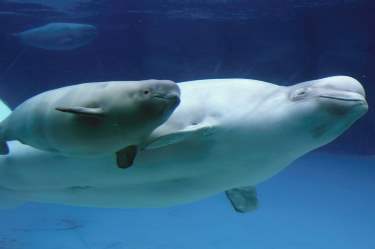
A particular highlight of visiting Canada’s scenic Hudson Bay is the chance to glimpse a pod of Beluga whales cavorting in the icy waters.
These oddly-shaped white whales’ name can be misleading. Beluga whales have nothing to do with Beluga sturgeon, the origin of upscale caviar. Rather, their name comes from the Russian word “beliy” meaning “white” hence the Beluga are “the white ones,” but here again, confusion is possible: Belugas are also unrelated to the “Great White whale” of literary fame — Moby Dick was a Great White Sperm Whale.
Belugas and the distinctive Narwhals belong to the Monodotidae family, a small subset of whales characterized by lacking any dorsal fins. This makes Monodotidae exceptionally comfortable in the icy waters of the Arctic since fins are a conduit for body heat. Monodotidae also feature a bulbous and malleable “melon” on their heads, which can change shape as the whale blows air through its sinuses. Researchers believe that the melon assists the Belugas to “echolocate,” their environment: the whale makes a clicking sound, which bounces off objects, then returns to the whale facilitating their navigation of the environment. It also assists with the perception of predators, and location of rich food foraging areas.
Belugas make their home in the Arctic at latitudes between 50 and 80 degrees North depending on the season. They remain remarkably loyal to specific locations along the icy coasts of North America, Asia, and Europe. Most of their time is spent foraging for food, which they source at depths of 1000 feet. On average, a Beluga whale eats 1%-5% of its own body weight, which means a daily diet of up to 15 lbs. of fish, crustaceans, and cephalopods.
Belugas are highly gregarious and socialized animals, traveling in pods made up of up to 100 whales. They more than earn their nickname of “sea canaries,” by noisily communicating with one another in a collection of grunts, whistles, clicks, and even sounds that resemble the irreverent “raspberry.” A calf remains with its mother for up to two years, feeding on her nutrient-rich cloudy green milk even after it begins to feed on solid food. Researchers have watched the Beluga calving process with interest, noting that the birthing mother is assisted by other adult helpers, who steward the newborn calf to the surface of the water just after birth.
The current population of Belugas is estimated to be 100,000, and their status by conservationists currently stands at “Near Threatened.” Researchers agree that the most significant challenge for Belugas and other Arctic animals is undoubtedly climate change. As ice shelves diminish, they will give way to an increase in shipping and oil exploration, which are potentially harmful to the Belugas’ food source. This also makes them more vulnerable to their traditional predators, killer whales, and polar bears, who corner the whales near ice shelves and haul them onto the surface. If climate change remains unaddressed, the Belugas will need to rely heavily on their traditional resilience and adaptability to both shallow and deep water, as well as their ability to support each other during the rigorous annual migration around the Arctic Circle.
Join Alexander + Roberts on an unforgettable day of whale watching in Hudson Bay on our Zodiac boats, where we often catch sight of the Beluga Whales coming to feed and mate in the shallow coastal waters. Speak to our knowledgeable reservation agents about our popular
Polar Bears of Churchill itinerary, which explores the Hudson Bay area.